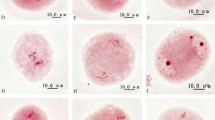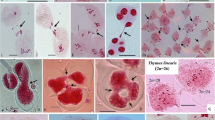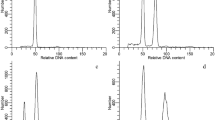Summary
Plants of two cultivars of 2x A. officinalis L. and two related ornamental species, 2x A. plumosus Baker and 6x A. densiflorus (Kunth) Jessop cv. Sprengeri were screened for production of pollen of heterogeneous size. Twenty four plants out of thirty-one studied produced this type of pollen, with frequencies of 3% or more large pollen. Some of these plants also produced giant grains. The numerically unreduced pollen arose by the lack of chromosome migration at Anaphase II in either one or both cells of a meiocyte, followed by the absence of cytokinesis in cells with abnormal chromosome behavior, a Second Meiotic Division Restitution (SDR) cytological mechanism. Double unreduced pollen resulted from a similar mechanism acting at both Anaphase I and Anaphase II stages. The high frequency of plants which produced 2n pollen in significant amounts is taken as an indication that the modified meiosis observed is under genetic control.
Similar content being viewed by others
References
Asker, S., 1980. Gametophytic apomixis. Elements and genetic regulation. Hereditas 93: 277–293.
Camadro, E. L., 1986. Los gametos 2n en el origin y la Evoución de las Angiospermas poliploides. Mendeliana 7 (2): 85–100.
Camadro, E. L., 1992. Cytological mechanism of 2n microspore formation in garden asparagus. HortScience 27(7): 831–832.
de Wet, J. M. J., 1968. Diploid-tetraploid-haploid cycles and the origin of variability in Dichanthium agamospecies. Evolution 22: 394–397.
Harlan, J. R. & J. M. J. de Wet, 1975. On O. Winge and a prayer: the origins of polyploidy. Bot. Rev. 41: 361–389.
Hermsen, J. G. Th., 1984. Mechanisms and genetic implications of 2n-gamete formation. Iowa State J. Res. 58(4): 421–434.
Iwanaga, M. & S. J. Peloquin, 1982. Origin and evolution of cultivated tetraploid potatoes via 2n gametes. Theor. Appl. Genet. 61: 161–169.
Johnston, S. A., T. P. den Nijs, S. J. Peloquin & R. E. Hanneman Jr., 1980. The significance of genic balance to endosperm development in interspecific crosses. Theor. Appl. Genet. 56: 293–297.
Marks, G. E., 1954. An acetocarmine glycerol jelly for use in pollen fertility counts. Stain Technol. 29: 277.
Marks, G. E., 1973. Selecting asparagus plants as sources of haploids. Euphytica 22: 310–316.
Mashkina, O. S., 1979. Ways of formation of unreduced microspores in the sweet cherry. Tsitologiya i Genetika 13: 343–346.
McCollum, G. D., 1988. Asparagus densiflorus cultivars Sprengeri and Myers cross-pollinations with A. officinalis and other species. Asparagus Newsletter 6(1): 1–10.
Mendiburu, A. O. & S. J. Peloquin, 1976. Sexual polyploidization and depolyploidization: some terminology and definitions. Theor. Appl. Genet. 49: 53–61.
Mendiburu, A. O., S. J. Peloquin & D. W. S. Mok, 1974. Potato Breeding with Haploids and 2n gametes. In: Kasha (Ed.) Haploids in Higher Plants. Guelph: University of Guelph, pp. 249–258.
Mok, D. W. S. & S. J. Peloquin, 1975. Three mechanisms of 2n pollen formation in diploid potatoes. Can. J. Genet. Cytol. 17: 217–255.
Núñez, O., 1968. An acetic-haematoxylin squash method for small chromosomes. Caryologia 21(2): 115–119.
Randall, T. E. & C. M. Rick, 1945. A cytogenetic study of polyembryony in Asparagus officinalis L. Amer. J. Bot. 32: 560–569.
Sala, C. A., E. L. Camadro, A. O. Mendiburu & M. T. Salaberry, 1989. Cytological mechanism of 2n pollen formation and sexual polyploidization in Lolium. Euphytica 43: 1–6.
Skiebe, K., M. Stein, J. Gottwald & B. Wolterstorff, 1991. Breeding of polyploid asparagus (Asparagus officinalis L.). Plant Breed. 106: 99–106.
Snow, R., 1963. Alcoholic-hydrochloric acid carmine as a stain of chromosomes in squash preparations. Stain Technol. 38: 9–13.
Stringham, G. R., 1970. A cytochemical analysis of three asynaptic mutants in Brassica campestris. Can. J. Genet. Cytol. 12: 743–749.
Swietlinska, Z., 1960. Spontaneous polyploidization in Rumex hybrids. Acta Soc. Botan. Polon. 29: 79–98.
Swietlinska, Z. & J. Zuk, 1965. Further observations on spontaneous polyploidization in Rumex hybrids. Acta Soc. Botan. Polon. 34: 439–450.
Winge, O., 1917. The chromosomes. Their number and general importance. Comp. Rend. Trav. du Lab. de Carlsberg 13: 131–275.
Author information
Authors and Affiliations
Rights and permissions
About this article
Cite this article
Camadro, E.L. Second meiotic division restitution (SDR) 2n pollen formation in diploid and hexaploid species of Asparagus . Genet Resour Crop Evol 41, 1–7 (1994). https://doi.org/10.1007/BF00051417
Received:
Accepted:
Issue Date:
DOI: https://doi.org/10.1007/BF00051417




